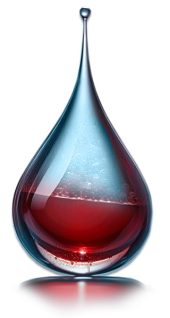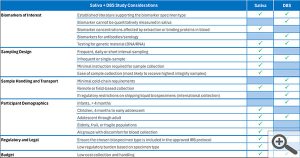Drop Date: April 2025
Better Biobehavioral Science: More Research is Needed
In the quest to unlock biological insights, researchers are continuously challenging themselves to consider and decide which sample type will best provide the critical data they need for innovation.
Blood has long been the go-to for many analytes, albeit with reduced timepoint sampling frequency and sample sizes. Saliva, as a more easily obtained sample, is well established for hormones, DNA and specific biomarkers, providing for deeper understanding through multiple timepoint sampling and larger sample sizes from populations. But today, innovative studies are discovering that the best answer to “which sample type?” might actually be “both.”
With the emergence of robust and validated research methods for Dried Blood Spots (DBS) as noted by Thom McDade, high-quality data for a wider set of biological markers can also be realized from a more easily obtained sample. Research has shown that participants, including older participants, can self-collect with high confidence. Together, sampling both saliva and DBS from participants makes for more comprehensive insights that can unlock the biological insights researchers are looking for.
Individually, saliva and DBS each open different windows into biology. Together, they throw the window wide open2. Here’s why using both in the same study can be so powerful:

New Study Ideas
Collecting both saliva and DBS ensures the measurement of a wider array of physiological systems. For instance, saliva can be used to measure stress hormones (cortisol, alpha-amylase, melatonin) and immune markers like Secretory IgA (SIgA), while DBS can be used to measure, among other markers, C-reactive protein (CRP), glycosylated hemoglobin (HbA1c) for metabolic status, or cytokines for inflammation. This combined approach gives a more holistic view of the participant’s biology.
Using both sample types can also create opportunities for data cross-validation and novel biomarker discovery. For example, a researcher can measure an inflammatory marker in both saliva and DBS, exploring how the two specimen types correlate and what that means (some markers might show faster changes in saliva and more sustained levels in blood). Equally impactful, a researcher may discover that a combination of a salivary hormone level and a DBS-derived protein marker together better predict an outcome than either alone.
New Study Methods
Importantly, asking participants for both saliva and a DBS sample still remains a low burden. A saliva sample plus a finger prick in one sitting is quite manageable, especially with clear instructions. From the participant’s perspective, it might add only a few extra minutes (do a quick finger poke after providing a saliva tube). However, from the researcher’s perspective, it doubles the data: two types of samples from the same effort. Because both can be done at home, participants can return both sample types together3.
The result is maximal information per participant which can strengthen findings, allow the researcher to achieve the same statistical power with a smaller sample size, and/or test new or multiple research study design methods that may lead to novel findings. Discovery comes from data.
If biobanking samples for future analyses, collecting both saliva and DBS now can future-proof a study. Today a researcher’s primary interest may be in, say, cortisol or insulin from saliva, but down the road, the researcher may want to assay plasma-only protein or examine metabolic health which would require blood. The study methods are yet to be developed for layering these two sample sets together.
Better Together
Recognizing the power of combining saliva and DBS, Salimetrics has developed services to support researchers in implementing both types of sampling seamlessly. We’ve long been champions of salivary research and now offer the same dedication to include DBS testing. We are committed to helping researchers do their best research.
Collection Kits.
Salimetrics can provide collection kits that include everything a participant needs to give a saliva sample and a DBS sample. We make it clear to participants that both samples are part of the process while keeping the process convenient. Our instructions are user-tested to be clear, and our support materials (videos, FAQs) help ensure participants of all backgrounds can successfully collect both samples.
Simplified Logistics and Laboratory Processing.
Salimetrics guides the process of sending saliva and DBS samples to the Salimetrics’ CoreLab+. Each sample type is handled through a specialized processing workflow, with a unified report of results. We deliver it all together, saving time while eliminating potential data handling errors.
Consultative Support for Study Design.
Not sure how to incorporate both sample types into your study protocol? Salimetrics is here to help. We regularly consult with researchers on designing studies that involve saliva and DBS. Questions like “Should participants give the saliva sample or the blood spot first?” or “How many DBS cards do we need per participant?” are common. We can provide recommendations, as well as advise on timing. Partnering with Salimetrics early in the planning sets the study up for smooth execution.
At Salimetrics, we believe that the best science happens when researchers have access to the best methods — and using both saliva and DBS is indeed one of the best ways to broaden and streamline your next study. Don’t limit your research; let Salimetrics help you harness the full spectrum of what saliva and blood spots have to offer.
If you’re looking to enhance your research program by incorporating biological measures, we close by simply offering the statement “Contact Salimetrics”. We are a research methods company, and helping researchers do great research matters to us.
REFERENCES & RELATED RESEARCH
- Evaluating SARS-CoV-2 Saliva and Dried Blood Spot Surveillance Strategies in a Congregate Population:
Andronescu, et al. Evaluating SARS-CoV-2 Saliva and Dried Blood Spot Surveillance Strategies in a Congregate Population. Emerging Infectious Diseases, Volume 29, Number 9—September 2023. https://wwwnc.cdc.gov/eid/article/29/9/23-0417_article - Anne-Christine Plank, et al. Comparison of C-Reactive Protein in Dried Blood Spots and Saliva of Healthy Adolescents Article. Frontiers in Immunology, 2021. https://www.frontiersin.org/journals/immunology/articles/10.3389/fimmu.2021.795580/full
- Eussen, S. J. P. M., et al. Feasibility of Collecting Self-Sampled Dried Blood Spots and Saliva in a Population-Based Study. BMC Medical Research Methodology, 15, 1–11 (2015). https://pmc.ncbi.nlm.nih.gov/articles/PMC4428002/
*Note: Salimetrics provides this information for research use only (RUO). Information is not provided to promote off-label use of medical devices. Please consult the full-text article.
 Contact: Salimetrics (USA)
Contact: Salimetrics (USA)
